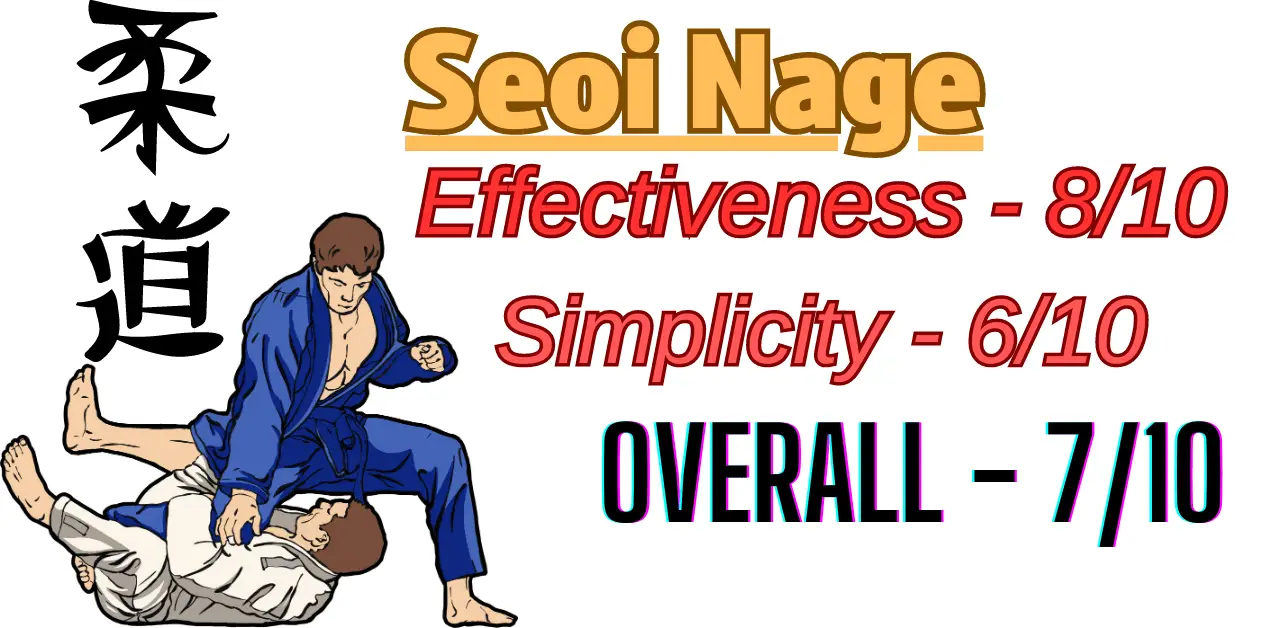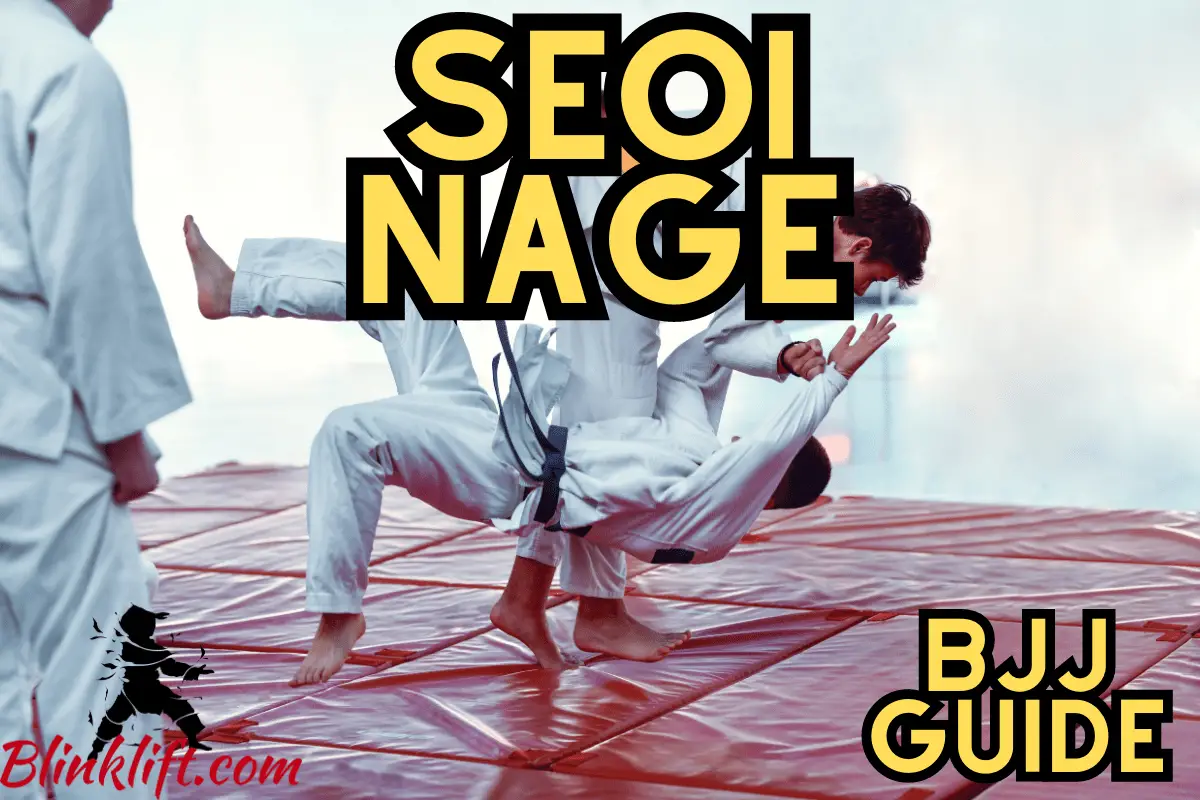The Seoi Nage, which translates to Shoulder Throw in Japanese, is a technique we typically see in Judo. However, it can be adapted to BJJ and Wrestling, which is what we’ll cover today. Although BJJ isn’t entirely about throwing and taking your opponent down, they’re still usable and effective techniques in it.
Therefore, familiarizing yourself and getting comfortable with takedowns—will open you up to a new world of opportunities. Not only will it help you attain a more dominant position, but it’ll also get you 2 points in a competition, which is fantastic for those competing in BJJ.
The Seoi Nage, or Shoulder Throw, is a takedown most commonly used in Judo, but also used in other grappling-based martial arts. It’s when you grab the opponent’s lapel, twist it under your armpit, drop it on your knees near your opponent’s feet, and take him down over your shoulder.
This article will be the only resource you need to learn and understand the Seoi Nage, primarily in BJJ. However, if you do Wrestling, Sambo, or Judo, you’ll also learn to utilize it in these martial arts. I know it’s a bold statement, but I’m confident this will be the only resource you’ll need.
And now, it’s time we cut the Chit Chat. We’ll now dive into the practical things you want to know before you start practicing the Seoi Nage. This is what we all came for, so let’s begin!

What is the Seoi Nage?
Before we start with the article. I want to make sure you understand something. I’ve thoughtfully ordered the article the way it is, so you can learn most optimally. However, if you decide to skip a section or two, you’ll find it more difficult when you start practicing. So although you might think you already know what I’m about to say, you might benefit from reading it.
The Seoi Nage is a takedown that utilizes your shoulder to lift your opponent and take him down. It’s most commonly used in Judo but is also seen in other grappling-based martial arts. You’ll be using your shoulder as leverage to flip the opponent above you, taking him to the ground.
I absolutely love takedowns in BJJ because it allows you to attain a more dominant position over the opponent. If you’re not a fan of that, you can also finish the fight by taking the opponent down and going for a submission. Simple as that.
However, the best move you can go for is to attain a more dominant position, such as Side Control and Full Mount. You’ll also be able to attain the North-South position and even the Back Mount. Indeed, these are all valid.
So now, let’s examine the execution process of the Seoi Nage.
How to perform the Seoi Nage
Alright. We’re slowly getting closer to more and more details. I hope you guys are excited about this section, as it’ll be your section to come back to if you want to have a better foundation for this move. Eventually, the better foundation you build by learning and mastering the basics, the easier the more advanced material will be.
The first step is to start standing up. This is how every fight begins, which is why takedowns are your friend.
Then, you want to establish a collar and sleeve grip, giving you upper body control. The Seoi Nage is built upon the fact that you have firm upper body control, so make sure you do that.
After doing so, you want to twist the opponent’s collar toward your armpit, which will grant you a better grip.
The next step is to lift the opponent’s Gi and step forward. Make sure to maintain your collar grip.
Once you step forward, you want to pivot and drop to your knees, ensuring your feet and knees are touching the ground. The position you want to be in is in line with the opponent but with your two grips still in place.
And finally, you use all the explosive force you can generate to lift the opponent over your shoulder and flip him. You’ll now be able to attain a more dominant position and keep attacking. In competitions, this will grant you tons of points.
In Judo, you’ll be able to get an Ippon, which is the highest score you can get at a single time.
Seoi Nage Variations
And now, let’s get into the most important part of this article: variations. The more variations of a move you know, the more capable and adaptive you’ll be when using it.
Your goal is to be as unexpected as possible. The best way you’ll be able to do that is by knowing as many techniques and variations as possible.
Who’s more likely to win, a grappler who knows 2 submissions or another who knows 25?
I’m confident that the grappler who knows 25 will have more attacking opportunities and will eventually get the victory more often than not.
So you understand that learning as many variations as possible is important. Here are the 3 primary variants of the Seoi Nage you must know about!
Morote Seoi Nage
The first variation we’ll review is the Moreote Seoi Nage. Now we’ve already covered this one, so I’ll keep it as brief and concise as possible.
The Morote variant is when you drop on your knees and use your back and shoulder to flip the opponent over you. This is why you want to maintain two hand grips, one in the collar and one in the sleeve, around the elbow area.
These two grips will grant you more control, which in turn will give you a higher chance of successfully taking your opponent down. Remember, the tougher and stronger your grips are, the more success you’ll find with the Morote variation.
Here’s what it looks like:
Ippon Seoi Nage
The Ippon Seoi Nage is harder to execute, let’s understand why. The Ippon variation uses only one hand on the opponent’s collar to take him down. Your other hand will be free. Therefore, you’ll need to use precise technique and timing to generate enough momentum through leverage to take your opponent down.
The first step is to start standing up. You then grip the opponent’s collar and twist it in the direction of the opponent’s forearm. The next step is to twist while stepping forward with your rear foot. Finally, you use your hand to drive your opponent on your back and use your back as leverage to take him down.
From there, you can attain a more dominant position in BJJ. In Judo, on the other hand, you will be able to get the Ippon, which will reset the fight.
But in BJJ, you’ll get 2 points for the takedown. But now, you want to start attacking, which you can easily do by attaining a dominant position and going for a submission.
If you want to learn about the best finishes from the Mount position, follow the first link. To learn about the best Side Control finishes, follow the 2nd link. And finally, to learn about the best top Half Guard submissions, follow the last link.
Learning to finish is as important as learning takedowns and using dominant positions. So don’t hesitate to follow the links.
Kata Guruma
The Kata Guruma variation is one of my favorites. Traditionally, it’s not a Seoi Nage variant. However, it can be characterized in the same group, as it includes the same mechanism.
As you’ll see, it’s a fancy-looking move you want to familiarize yourself with. It’s sometimes referred to as the Fireman’s Carry, which you’ll see why soon. So how do you perform it?
You first start standing up and grab the opponent’s sleeve (elbow area.) Then, you step forward with your rear foot while crouching. You then want to place the arm you gripped over your shoulder while grabbing the top of his thigh. Finally, you lift your opponent, as if you’re carrying someone.
From there, you can throw him to the ground. This move is legal in BJJ, as long as you’re not throwing your opponent’s head to the mat. So keep that in mind when executing it.
Seoi Nage Tips
And now, let’s dive into the last section of this article. This is the most advanced part, where we’ll review three optimizations you can make to boost your success odds with the Seoi Nage, in all its variations. While these tips apply to all takedowns, they’re effective with this one particularly.
So let’s dive into the 1st tip!
#1 – Establish a strong grip and control
The best thing you can do is establish a stronger grip. This will skyrocket your success rate with the Seoi Nage, and most other takedowns. So before you execute this takedown, make sure you get a firm Lapel grip over your opponent.
#2 – Timing and off-balancing
The 2nd tip is critical to understand. You must use timing to off-balance your opponent effectively. You’ll need to invest a lot of effort to lift an entire human being over your shoulder or back. Therefore, play around with the timings when you’re practicing.
See when it’s easiest to execute this move. All in all, the best timing is a smooth one. So make sure to execute everything smoothly, without hesitating in the middle.
#3 – Engage your entire body
Seoi Nage relies on the coordinated movement of your entire body. As you step forward and pivot, engage your hips and core to generate power and drive. Focus on driving through your legs and transferring the force into your upper body. This integration of the lower and upper body will enhance the effectiveness of the throw.
Final Words
You’re now able to practice and execute the Seoi Nage in BJJ, Judo, Wrestling, or any other grappling martial art; congratulations!
What you want to do next is start gaining real experience. You can do that by getting on the mat and starting to Seoi Nage everyone you see. Literally, tell your training partners to come by because you need to try a takedown you just learned—on them.
Soon after, you’ll be able to execute this takedown flawlessly. Remember, there’s no replacement for real practice.
The Seoi Nage, however, isn’t the most effective takedown BJJ has to offer. If you want to start getting more takedowns that will give you more points in competitions and more wins in both competitions and street fights, here are the 9 best takedowns in BJJ! Follow the link to learn more.
Here are other articles you’d enjoy reading:
Arm Drag Takedown – Complete Fighting Breakdown
Foot Sweep Guide (For BJJ, Judo, and Wrestling)
BJJ 101 – Double Leg Takedown (Variations & Finishes
Single Leg Takedown 101 – BJJ Comprehensive Guide
Ankle Pick 101 (BJJ) – How to Execute Properly
Pull Guard BJJ – Everything You Need to Know

